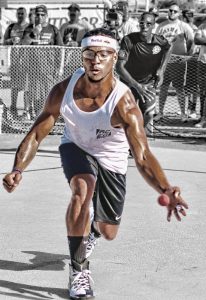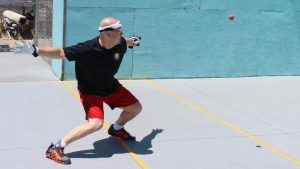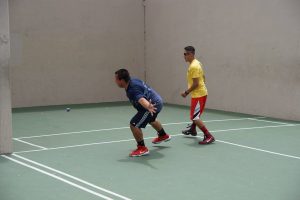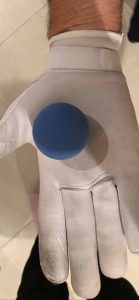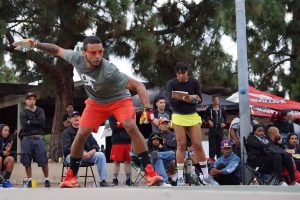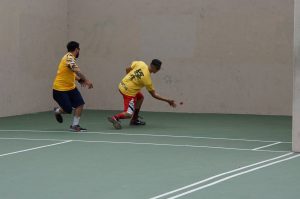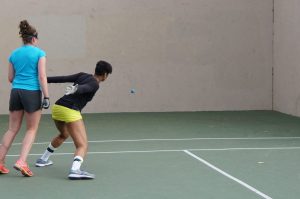The WPH Coaching Center has discussed Coaching, How to See a “Fast Ball,” The Six Walls, The Most Important Shot, The Diet, What Separates Paul Brady, The 3-Wall Power Serve and much more. The WPH Coaching Center will continue to examine the various strategies and shots that will make you a better handball player, with this week’s WPH Coaching Center will analyze the Paddle Kill.
The Paddle Kill is a devastating front court shot that can earn points with very little effort. David Chapman made the Paddle Kill famous, redirecting the most powerful shots in the game one-inch high for rally-enders. Since Chapman made the Paddle Kill a staple in his game, Danny Bell, Robbie McCarthy, Emmett Peixoto, Diarmaid Nash, Stephen Conney, and Tracy Davis are among a few of the game’s greats who have employed the Paddle Kill with great success.
On this special edition of The WPH Coaching Center, we’ll have a chance to learn from several of the game’s greatest “Paddlers,” as David Chapman, Stephen Cooney, Danny Bell, Emmett Peixoto, and Diarmaid Nash take us through how, why, and when to hit the Paddle Kill.
How to Hit the Paddle Kill
Before attempting a successful Paddle Kill, you need to know the proper mechanics and technique behind this seemingly simple shot. Each of these great Paddlers hits the Paddle Kill slightly differently. Head to the courts and see who’s style works best for you.
(From the Chapman Instructional II video HERE): The Paddle Kill does not use a traditional swing, but proper footwork is crucial to the shot. One of the differences between the Paddle Shot and the sidearm swing is that with the sidearm swing you are leading with your elbow, and with the Paddle Shot you are leading with your hand. In the Paddle Shot you are using an enlarged hand, you are not cupping your hand. You are opening your fingers up and following through with an open hand. When you are executing the Paddle Shot make sure your body is moving forward and you are staying low (coming up on your back toe on the follow through). You also want to make sure you hit this ball off your front foot.
Stiffen your arm and tense your bicep to turn your arm into a paddle. The arm can be bent or straight as long as you just move from the shoulder with the elbow locked in position. Push through the ball. Unlike most other shots, you are always told to swing through the ball. This shot is the exception. You push into the ball and guide it to its intended direction. You don’t offer the ball anything but a stiff-arm and wrist and direction. The momentum that is on the ball will be all that’s needed to execute this shot.
Emmett Peixoto:
Keep both arms out to the side of your body so you can adjust if you have to take the ball with your right or left. Once you know what hand you will use, turn your body toward that side while keeping the elbow of your hitting hand close to your body (so your hand goes further back, away from the front wall, along with your body turn). Try your best to step into the shot while you swing, keep your wrist limber and arm – from wrist to elbow – straight as you can. The hand should finish over your shoulder when you complete the swing. You are not trying to guide the ball and you are not trying to hit it hard. Place the ball while you swing, watching the ball all the way to your hand. You have to be very confident you will hit the ball where you want and make sure you do not back away from your shot.
The technique is no wrist and no elbow movement. Just tap the ball with the palm of the hand – this is the point of contact. This shot requires a lot of finesse from the back of the court. It is a shot that allows you to save your arm. It is a low percentage shot for most players because if you miss it, it will give a perfect set up for your opponent. It can be used from anywhere if you really control it. Dave Chapman was the master and the inventor of the Paddle Kill. That’s by watching him that I realized that you could win volleys with no effort, because that shot doesn’t require strength and a full swing. In order to développe it, you have to play and accept you will lose a lot of points in practice to be able to control it.
When to Hit the Paddle Kill
As with all handball shots, the when is equally important as the how. Let’s revisit our panel of Paddling legends to learn when to hit this deadly touch shot.
(From the Chapman Instructional II video HERE): The Paddle Shot can be used as a two-way shot. You can go for the kill but the ball can slide down the wall (for more of a pass). By hitting the Paddle Shot right back to yourself, it either creates a hinder or a point for me. I mainly use the Paddle Shot as a fly kill opportunity. This keeps my opponent off-guard, as it’s more difficult to read a Paddle Shot than a traditional swing. The Paddle Swing is more efficient when you don’t have a lot of time to set up for a full sidearm swing.”
Diarmaid Nash
(From the WPH Handball Terminology video HERE): The Paddle Shot is like a dump shot. If your opponent hits the ball very hard at you, you take all the pace off the ball and you just try to dump the ball into the corner by just touching the ball so it bounces twice and dies very quickly.
Stephen Cooney
Hold your backswing at the top for an extra second. Overemphasizing your backswing to lead to your opponent thinking twice as to where you are hitting the ball, thus disguising the Paddle Kill and leaving your opponent flat-footed when you place the ball back where it came from.”
The Paddle Kill is best used when you manage to get a player behind you: the further back the better. The previous shot should be such that the player is doing their best to simply return the shot, such as a well-placed pass shot or a well executed ceiling ball (i.e., one that drops low off the back wall, so they will have a weak return if they decide to take it off the back.)
Danny Bell
The Paddle Kill is easier to use from the middle of the court if the ball comes fast and right at you. From the back it is riskier, and it needs a lot more finesse but is very effective if the opponent is not looking at you or is also in the back of the court.
Benefits of the Paddle Kill
The Paddle Kills offers a number of benefits, from reducing the strain on your elbow and shoulder, to being able to disguise your shot.
(From the Chapman Instructional II video HERE): The Paddle Shot can be used as a two-way shot. You can go for the kill but the ball can slide down the wall (for more of a pass). By hitting the Paddle Shot right back to yourself, it either creates a hinder or a point for me.
Danny Bell
The Paddle Kill is a shot that can extend the career of certain players like me who had a lot of shoulder and elbow problems after a long career.
How to Defend Against the Paddle Kill
Now that we’ve learned how and when to hit the Paddle Kill, let’s learn how to defend against it.
Danny Bell
The players who had a lot of success picking up the paddle kill are the ones who really focus on the style of the other player instead of focusing on their own game. For example, Killian and Stephen Cooney were very successful against my paddle kill because they knew I was using it a lot and they were diving a lot to make great gets, unlike other players. Even if my shots were not bad, they were always there to make the get.
Paddle Kill Envy
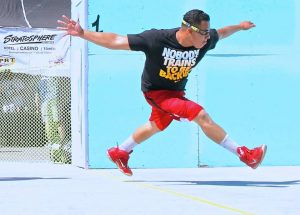 “I never had the Paddle Shot,” barked Hall of Famer John Bike. “I just stood and stared in amazement and jealousy of their hand eye coordination.”
“I never had the Paddle Shot,” barked Hall of Famer John Bike. “I just stood and stared in amazement and jealousy of their hand eye coordination.”
The Bicrowave is not alone, as countless pro and amateur players watch in awe as the game’s best Paddlers end rallies with paddle shots.
We don’t have to be in awe anymore, as our Paddle Squad of Dave Chapman, Emmett Peixoto, Stephen Cooney, Diarmaid Nash, and Danny Bell have unlocked the secrets to this coveted shot.
Send us a video on your Paddle Kill and we’ll have a member of the Paddle Squad analyze your technique.
David Fink
WPH Senior Writer










